Most of us play the majority of our rounds on one course. In fact, golfers posting scores for their handicap play their “home” course about 75 percent of the time. You probably don’t think much about that, except maybe to wonder why you keep messing up the same holes. The good news is, with a little analysis you can tailor your game to your course, or fill a gap that’s killing your scores – three-quarters of the time!
For example, if your course is lined by trees, you might need to drive the ball straighter. If you feel like you have a mile into every green, it’s smart to work on your fairway woods and hybrids. If your greens have crazy slopes, you’d better know how to read break. This magazine offers a ton of great instruction, but it’s usually up to you to decide if the tips apply to your game. Here we’ll help you pick and choose based on where you play.
Work your way through this article, and you’ll start to understand what your course is asking of you – and start answering the call more often. This is why teaching pros give playing lessons: they want to help students improve on their home course. So consider this your first playing lesson. – with Peter Morrice
If you struggle to reach the green in two shots on most of the par 4s, you need…
Driving Distance
Power comes from hitting from the inside out. To do that, your lower body has to start the downswing – that’s what keeps the club to the inside. Your hips shift towards the target and start to unwind, pulling your upper body and then your arms and club through the ball.
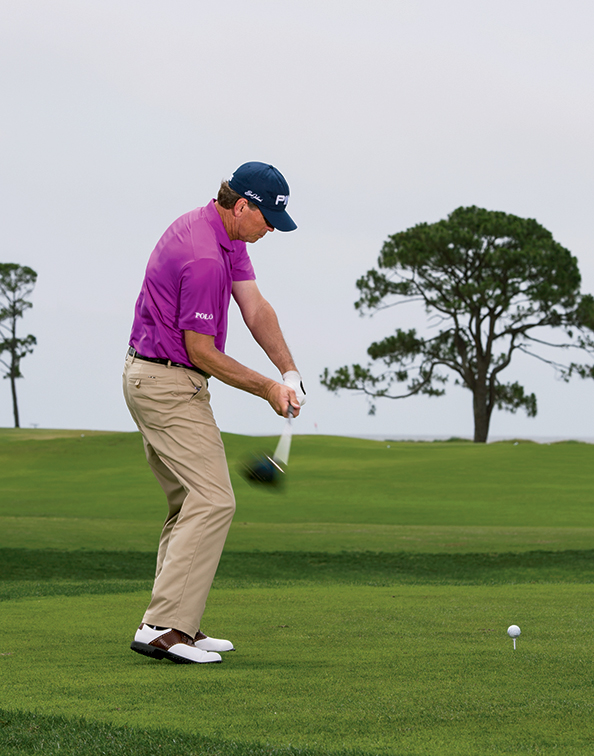
As the lower body rotates, it creates an outward force on the arms. This is the slinging action you see in long hitters. To get it, you have to let your arms simply drop from the top of the swing. We call that “dropping in the slot”. Then you can take advantage of the energy created by your body turn. The rotation throws your arms and club out to the ball [above].
A good feeling is that your right arm goes from short as it drops down, to long as it extends through impact.
Don’t Make This Mistake
A lot of golfers make an aggressive upper-body move to start down. That throws the club to the outside prematurely. Think, shift, turn, then sling.
If you have to hit a recovery shot after your drive three or more times a round, you need…
Driving Accuracy
Understand that the position of the clubface at impact has the biggest influence on where the ball goes. That’s most evident on tee shots.
First, check your grip. When you look down at address, you should see at least two knuckles of your left hand (for righties). The Vs formed by your thumb and forefinger of both hands should point just inside your right shoulder.

With a good grip, think of the back of your left hand as a mirror of the clubface. Wherever that hand is facing, that’s where the clubface is pointing. This image works great because face position is a tough thing to feel. For straighter tee shots, imagine that the logo on the back of your glove at impact is pointing on a line parallel to your target line [above].
Don’t Make This Mistake
If your logo is pointing up at impact, your right hand is scooping, and your left wrist cupping. Focus on keeping that left wrist flat – and that logo facing out.
If most of your shots into the greens are outside of iron distance, you need…
Woods/Hybrids
Making thin contact with the longer clubs from the fairway produces low shots that don’t reach the green. The design of fairway woods and hybrids puts more loft towards the top of the clubface, so you need to get the bottom edge of the club below the bottom of the ball to make contact higher on the face.
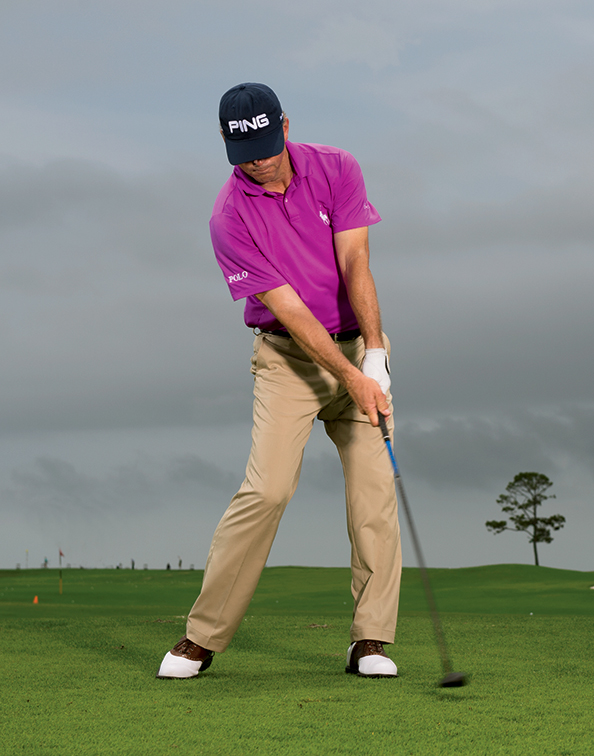
The feeling you want is, you shift to your front side and then extend your arms and swing the clubhead low through the shot. Keep it low after the strike, with your arms staying long. Try to maintain through impact the triangle formed by your arms [above].
Don’t Make This Mistake
Falling back on your right foot and trying to help the ball up creates those thin hits. Make sure you shift left and extend those arms.
If most of your shots from the fairway are from uneven ground, you need…
Sidehill Lies
Here’s the key concept for sidehill lies: the ball will go in the direction of the slope. So when the ball is below your feet, it’ll tend to go right; when it’s above your feet, it’ll go left. The main thing is setting up correctly and adjusting your aim.

At address, make sure the clubhead is flat on the turf – with the toe and heel, front edge and back edge all touching the ground. With the ball above you, grip down, aim right, and swing more around your body. With the ball below you, bend over more, aim left, and swing more up and down. It’s also a good idea to shorten your swing for control [above].
Don’t Make This Mistake
Never fight the slope. Sole the clubhead flush to the ground, and stay in your posture as you swing.
If most of your shots into the greens are with 7-iron or less, you need…
Short Irons/Wedges
Good players know the critical skill on short approaches is distance control. Inconsistent contact can produce a 9-iron of 120 metres on one hole and 135 the next. The key is to compress the ball the same way every time, which is easier to do with a three-quarter motion. Think of it as a shoulder-to-shoulder swing: Swing to shoulder height back and through [below].

Play the ball middle, and set more weight on your front foot. At impact, make sure your weight is left and your hands are ahead of the ball. That’s a downward strike. You’ll see more consistent distances with these clubs.
Don’t Make This Mistake
Never try to blast your short irons. More speed often leads to a higher trajectory and a harder time controlling distance.
If you have to pitch over trouble more than three times a round, you need…
Lob Shots
When you miss the green on some courses, you have deep rough or a bunker between you and the hole. That’s when you have no choice but to play a lob shot. First thing you need to realise is, you’re already out of position. Your priority is to get your next shot on the green, even if it’s 15 or 20 feet past the hole. Don’t get cute with it.
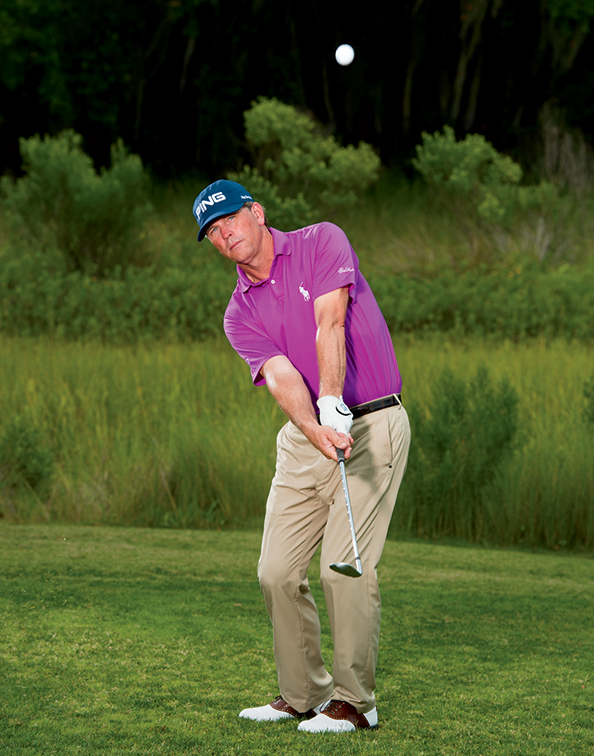
Using your most-lofted wedge, turn the face open, then take your grip. Aim your body left, and visualise the ball flying all the way to the hole. The swing is simple: fold your right arm going back, then straighten it going through [above]. Make sure you keep the face pointing skywards as you thump the ground under the ball.
Don’t Make This Mistake
Most golfers don’t hit these shots hard enough. You have tons of loft working for you, so give it some swing and try to fly it to the hole.
If most of your greens are raised or have closely mowed chipping areas, you need…
Bump-and-Runs
A lot of modern courses feature elevated greens with shaved banks [below]. Your first choice for getting up these hills should be the putter or your putting stroke with a hybrid or fairway wood. But what if the turf is bumpy or wet? Then the safe play is bouncing an 8 or 9-iron up to the green.
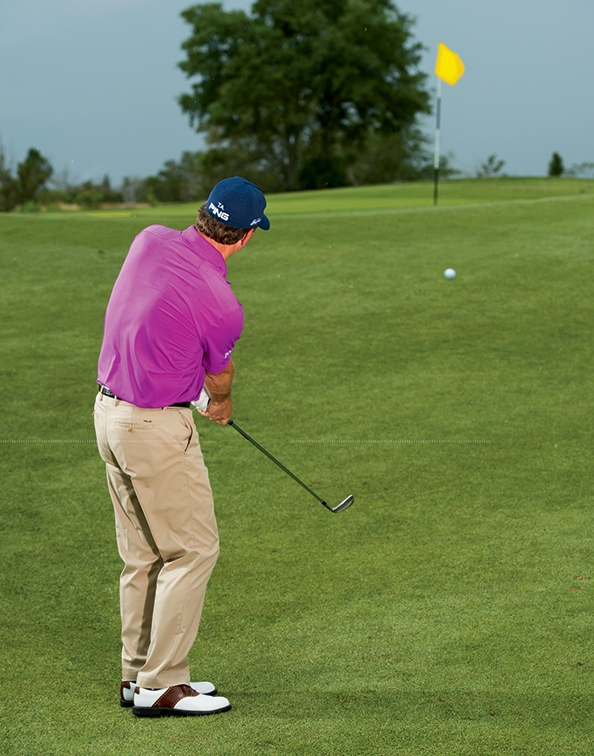
To bounce it, play the ball just back of centre, push your hands ahead, and lean your upper body towards the target. Make enough swing back and through to land the ball half to two-thirds of the way up the hill, depending on the firmness of the ground.
Don’t Make This Mistake
Yes, you can lob the ball onto the green, but that’s the riskiest shot. Only do it if you have a perfect lie and the nerve to pull it off.
If you end up in the sand after missing the green several times a round, you need…
Greenside Bunkers
The best pros average 2.3 strokes to get in the hole from greenside bunkers, so getting down in three is a good goal for most amateurs. The key is controlling where you splash the sand. You want it to be up by your front foot, not back in your stance.

To position your splash forward, play the ball off your front foot and set more weight left. A good tip is to angle your right knee in, even raising your right heel an inch off the sand [above]. That will pre-set your entry point in the sand farther forwards. To judge distance, use a 3-to-1 ratio compared to a pitch shot from the grass: a 10-metre sand shot requires a swing that would send the ball 30 metres from the fairway.
Don’t Make This Mistake
If you play the ball too far back, you have to get behind it during the swing to splash it out. Play it up, lean forwards and swing away.
If you routinely face putts that break more than a metre, you need…
Big Breakers
The first thing to do on breaking putts is visualise the entire arc of the putt and picture where the ball would enter the hole. You want to give it a chance to drop in on the high side. Then find the apex, or outside point, of the break. That’s where you should be starting the ball.
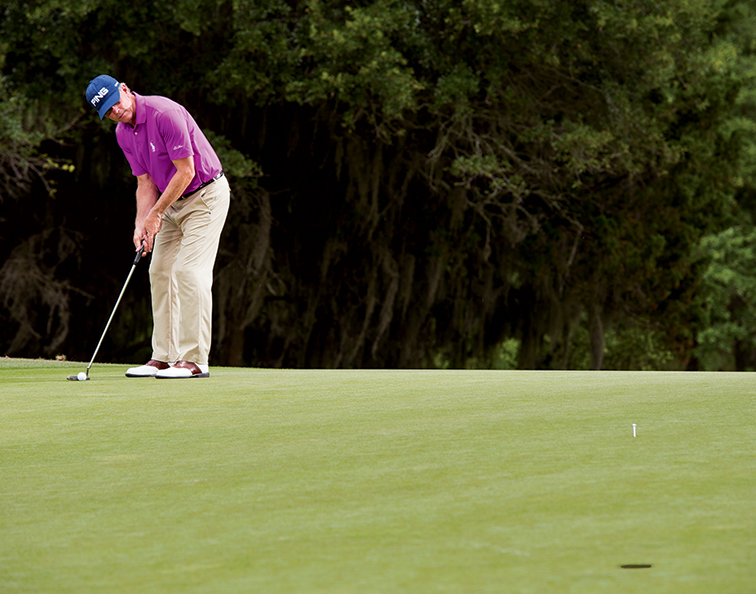
Imagine a gate or post at the apex [above]. You’re like a slalom skier turning around a gate, and just like in skiing, speed is the critical issue. If you give the putt more pace, it won’t break as much; give it less, and it’ll break more. But you’re always working around that apex. As you stand over the ball, track your eyes through the apex to where the ball should enter the hole.
Don’t Make This Mistake
Most golfers don’t commit to enough break. When they look up, they subconsciously adjust their aim towards the hole. If you’re missing on the low side, try making your last look only at the apex.
If you routinely face putts that are longer than 10 metres, you need…
Lag Putting
The standard advice to putt with your shoulders doesn’t work for the long ones, where you need a little wrist action for more power. The putterhead has to swing behind the grip more on longer putts. That loading of the club will provide a little release through impact so you can apply more energy to the ball.
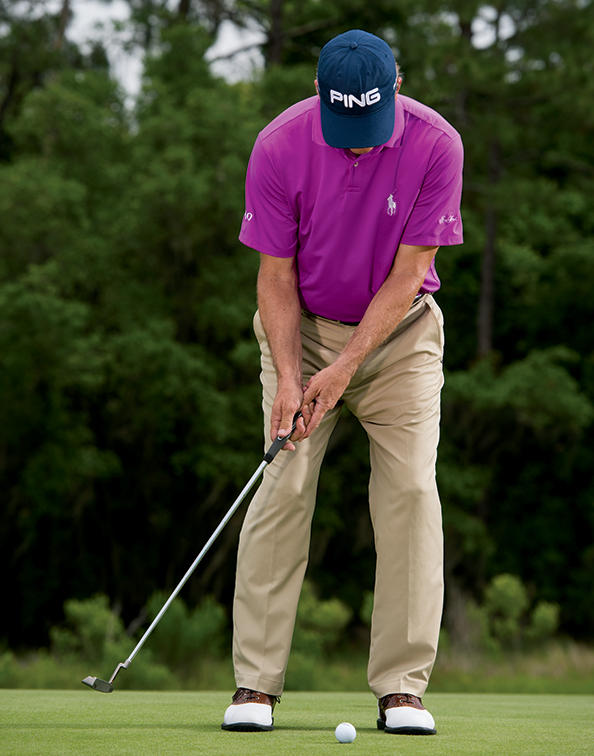
You want to feel that you’re letting your right wrist bend more (or your left wrist flatten) as you swing the putter back. The hands should never swing outside the body; in other words, they never go past the back leg [above]. If you need more power, just hinge your wrists more, and always let the putter accelerate through.
Don’t Make This Mistake
Locking your wrists and rocking your shoulders causes excessive body movement and leads to inconsistent contact with the ball. Allow your wrists to hinge, and you’ll naturally stay steadier.
– Todd Anderson, a Golf Digest Teaching Professional, has worked with many tour players, including Billy Horschel, Justin Leonard, Brandt Snedeker and Nick Watney.




